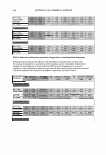420 Properties Dispersion (3) in PEG7 Methyl Ether SPF/%TiO2 Critical Lambda UVA/UVB SPF Change SPF/%TiO2 Critical Lambda UVA/UVB SPF Change SPF/%TiO2 Critical Lambda UVA/UVB SPF Change JOURNAL OF COSMETIC SCIENCE In TiO2 in oil Dispersion phase, solvent added last In water phase U1 U1 1.39 2.64 312.4 ., .. 3B1.5 381.65 .. ,. 0,711 0.717 0.757 UI 1.21 NIA 1.51 aJUI NIA 381.2 NIA 0.705 317 NIA 3.08 171.111 N/A 380.2 NIA 0.709 Table 6. Polyether (PEG 7 Methyl Ether) dispersion versus controls added to water phase, oil phase or final emulsion. Overall, both performance and aesthetic aspects, especially transparency as demonstrated by draw down films and skin application, point to control by parameters of the initial inorganic pigment chosen for UVR attenuation and the way it is dispersed in the skin film. Methods need to advance to the stage where skin film particle size and SPF can be determined simultaneously site by site for more accurate assessment of film differences. Even within the scope of current technology, additional experiments need to be conducted to support the hypothesis that optimal performance occurs with optimal dispersion in the product film after rub in and dry down on the skin. Directionally, these preliminary results point to getting the active particles well dispersed in the continuous phase that lays down on the skin. But this is also linked to the nature of the emulsion as it breaks down on the skin and where those particles eventually go to effectively absorb, reflect and diffract UVR with limited effect on visible light to make their efficacy invisible.
2004 ANNUAL SCIENTIFIC SEMINAR 421 THE STUDY FOR RETINOL STABILITY USING 3-DIMENSION Jung Sik Choi and Hong Geun Ji Department of R&D Center, H & A Pharma Chem., Bucheon-si, 421-080, Korea Introduction In these several years, the functional materials have attracted many people being engaged in cosmetics and pharmaceutics because of their infinite application. Retinol is one of those kinds of materials owing to a wide variety of biological functions such as palpating embryonic growth and development, vertebrate vision, immune reactions and epidem1al di:ff erentiation. It is also a prime candidate for cancer prevention. [ 1-3], However its efficaciousness is falling down as time is going by, because vitamin activity is decreased by isomerization, photochemical oxidation and thermal oxidation. Such degradation reactions can also reduce vitanun activity of stored and processed foods. In general, the stability of retinol and its relatives is gently declined in condition of high humidity, low pH and high temperature. [ 4] Retinol is a fat-soluble material and abundant in fish and mammalian liver, milk fat and egg yolks. Due to its hydrophobic character, it is usually found in a complex with lipid droplets or micelles. If this system, liposome, could be applied, we could expect to protect retinol from degradatiYe reactions.[5-6] Liposome is spherical closed vesicles of phospholipid bilayers with an entrapped aqueous phase. The lipid layers are mainly made up phospholipids that are amphophilic. In aqueous solution, they are arranged in bilayers, which form closed vesicles like artificial cells. In the cosmetic area, liposome is used to stabilize the tmstable materials against exterior condition (air, light, oxygen, etc), maximize their efficacy and enhance skin absorption by phospholipid having the great affinity for skin. The stability and delivery of liposome-incorporated retinol has been studied in several articles. However, the stability of retinol in liposome has not been sufficiently studied. [7] Materials and Experimental Materials In this experiment, Retinol 50C (1.58 Million LU.lg, BASF), Lipoid S 100-3 and S 75-3 (Lipoid) are used as received. Other material also are commercial available. Purified water passed tluough an anion cation exchange resin column is employed. Experimental The stability and skin penetration of retinol are improved by 3-dimensional method. As I-dimension, porous silica is prepared using sol-gel method, and then retinol is entrapped into mesoporous silica. As 2- dimension, solid lipid nanoparticles (SLN) containing retinoland silica are obtained by high pressure
Purchased for the exclusive use of nofirst nolast (unknown) From: SCC Media Library & Resource Center (library.scconline.org)






































































































